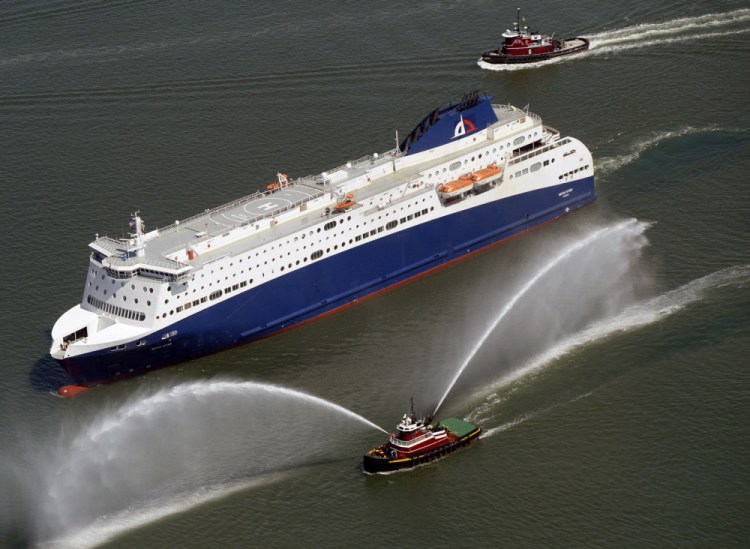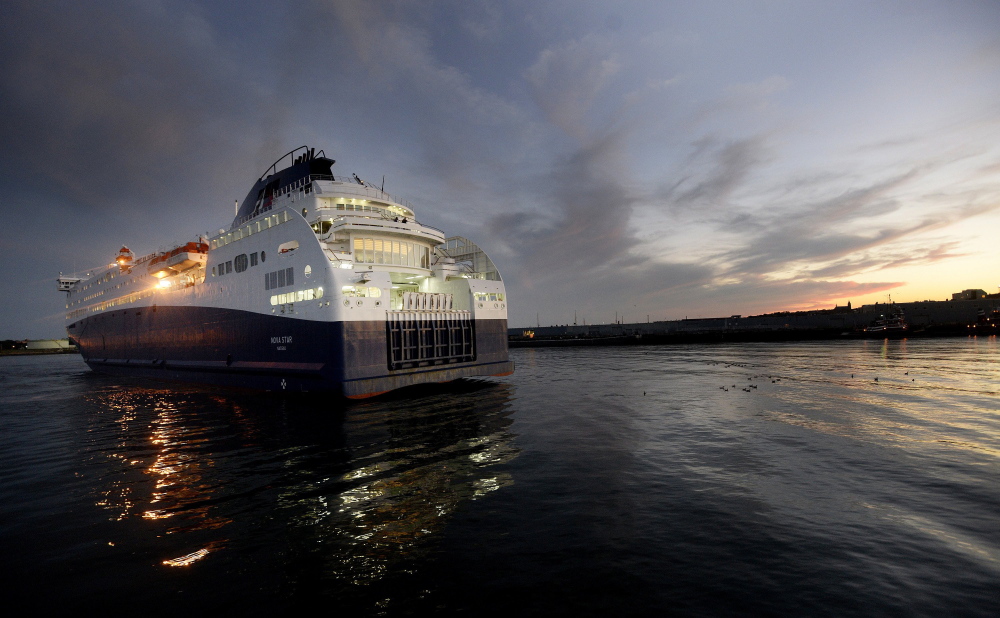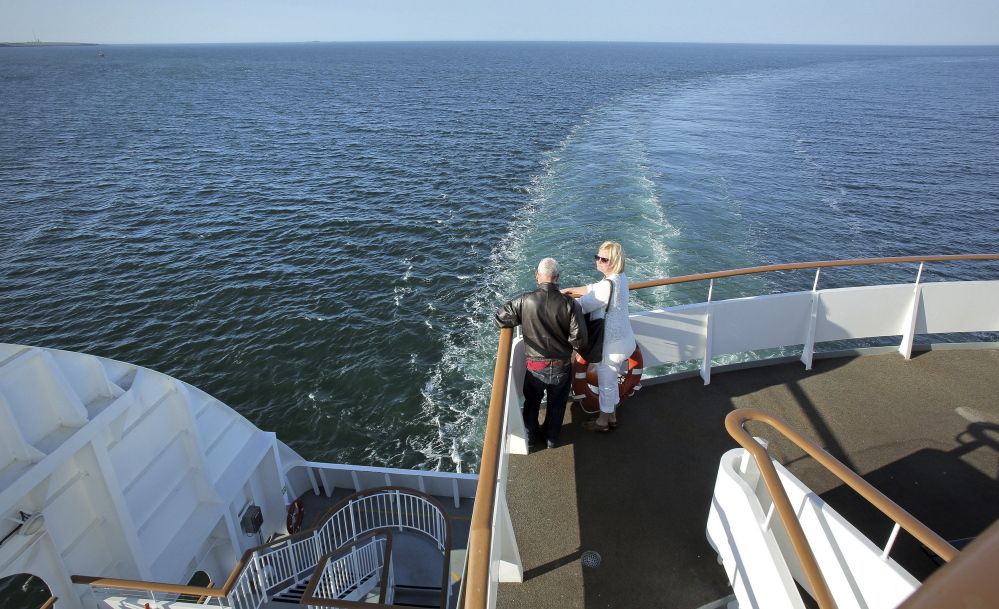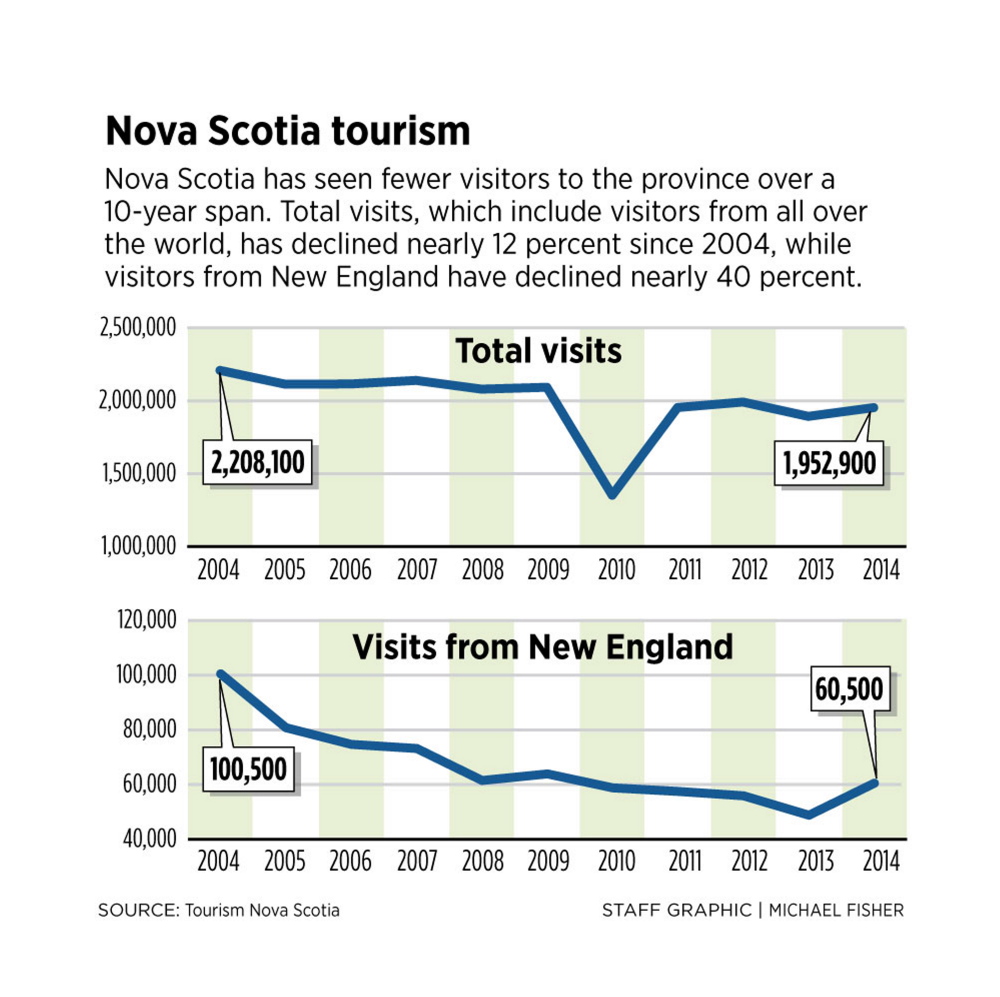Thirty-six years ago, Stephen Pickford crossed the Gulf of Maine on the M/S Caribe, one of seven ferries that have traversed the route between Yarmouth, Nova Scotia, and Portland since 1970. Between 400 and 500 passengers packed the ship, he recalls.
Pickford returned last week to ride the Nova Star on a sentimental journey to retrace that trip. The food and service were excellent, he reports, but the ferry’s corridors and public rooms were oddly quiet. Only 108 passengers made the crossing with him from Nova Scotia. The ship can comfortably carry 750.
Pickford, who hosts a Montreal-based radio show about world travel, said the Nova Star may have fewer passengers than past ferries because the travel industry and people’s vacation habits are a lot different from what they once were.
“There are so many more options,” he said. “The world has changed.”
Pickford may be on to something.
While critics of the troubled Nova Star service say it would do a lot better if it had a less expensive vessel or a more savvy operator, experts in the ferry and tourism industries say that the ferry service has suffered from large-scale shifts in society and business:
• Americans are taking shorter vacations than they used to. The well-planned, two-week family excursion has been replaced by the last-minute weekend get-away. Many Americans don’t have the time to travel all the way to Nova Scotia and back, no matter which mode of transportation they use.
• The explosive growth of the $117 billion global cruise ship industry has given consumers more options for travel at sea. Between 2009 and 2013, the number of people who took a cruise trip annually rose from 17.8 million to 23 million, an increase of nearly 30 percent, according to industry data. The cruise industry has done this by containing costs and giving consumers value for their money.
Holland America, for example, is now selling a seven-day cruise to Montreal from Boston with two stops in Nova Scotia, for $1,391 for two people in an interior cabin, meals included.
Nova Star sells a 24-hour cruise for $380 for two people in an interior cabin, meals not included.
Three cruise companies currently offer cruises out of Boston – Nova Star’s primary market – that stop in Nova Scotia, and five cruise companies offer trips from New York City. While traffic to Nova Scotia is down elsewhere, cruise ships are on the rise. Since 2000, the number of people calling on the Nova Scotia ports of Halifax and Sydney increased 85 percent, from 162,000 to 300,000.
PRESSURE FROM COMPETITION
The rise of the cruise ship industry has hurt other ferry services. Ryan Burles, president of Black Ball Ferry Line, which runs a daily vehicle and passenger ferry service between downtown Victoria, British Columbia, and Washington state, said passenger volumes have fallen about 25 percent since 2002. While the ferry service is slowly rebounding, he said, competition with the cruise ship industry will prevent the company from achieving its peak passenger levels of the early 1990s.
• Tour buses were a big part of the revenue stream of the Scotia Prince, one of Nova Star’s predecessors, which operated the Yarmouth-to-Portland run from 1983 to 2004. But the tour bus industry has struggled since the late 1990s and early 2000s because of higher insurance costs, consolidation and lower consumer demand, according to a study by the International Business & Economics Research Journal.
• The terrorist attacks of Sept. 11, 2001, caused the United States to require American citizens entering the U.S. after visiting Canada to show their passports or enhanced driver’s license. Fewer than half of Americans have a passport or passport card, according to the U.S. State Department.
Because of increased border security, travelers taking a 24-hour cruise on the Nova Star are now required to get out of bed, leave the ship, clear customs and then get back on the ship.
• Part of the appeal of the Scotia Prince was its casino – a significant draw for passengers. During its operation, the nearest slot machines were in Atlantic City, New Jersey, and later in southeastern Connecticut. Although the Nova Star also has slot machines and card tables, the opening of Hollywood Slots in Bangor in 2005 and the Oxford Casino in 2012 has given consumers who want to gamble other options.
• The deregulation of airlines and the rise of discount airlines have made it cheaper for people to travel by air. It’s not that Americans are flying to Halifax instead of taking the ferry. Rather, they are flying to places like Las Vegas and Orlando.
• Highway construction in New Brunswick and Nova Scotia has made it faster to drive between Maine and Nova Scotia. The biggest improvement was a $500 million project in New Brunswick, completed in 2012, that allowed motorists to travel on a 150-mile divided highway between Calais and the junction with the Trans-Canadian Highway about 75 miles north of Saint John. The improvements have cut about half an hour off the trip. It now takes about 10 hours to drive from Portland to Yarmouth, about the same time as the ferry takes to get there.
• A surge in the value of the Canadian dollar between 2002 and 2013 made travel to Canada more expensive for Americans. The Great Recession in 2008 and 2009 and the slow economic recovery afterward caused many American families to pull back on travel spending. The American dollar has surged in value in the past year, but travel habits have changed, and it may take time for Americans to discover their money has more buying power in Canada now.
• Many families in New England and Nova Scotia have relatives on both sides of the Gulf of Maine. Those ties date back to the 1800s and early 1900s, when thousands of Canadians from the Atlantic Provinces emigrated to the “Boston States.” For generations, a significant percentage of American tourists in Nova Scotia were visiting relatives. But the passage of time and the domestic migration of families to distant parts of the U.S. and Canada have weakened those family bonds, said Glenn Squires, chairman of the Tourism Industry Association of Nova Scotia.
“When they were young, they would come to Canada every summer,” he said. “Now they don’t come back anymore.”
HEADWINDS FOR FERRIES
All of these factors are changing the tourism landscape in which the ferry service tries to compete. Officials in the Nova Scotia government are trying to decide whether to award the ferry operator, Nova Star Cruises, a contract for next season, or to replace the operator and keep the ship, or perhaps replace the operator and also replace the Nova Star with an older, less expensive ship.
The ship is carrying far fewer passengers than the government had anticipated. A 2011 consultant hired by a Yarmouth business group projected the service would carry 120,000 passengers in the first year. A different panel working for the provincial government in 2012 projected the service would carry 110,000 passengers.
Instead, the Nova Star carried 59,000 in its first season.
The numbers were expected to improve this year because the company had more time to market its service to bus tour companies, but the ferry is on pace to carry even fewer passengers than its inaugural season. Through August, the ferry had carried 37,800 passengers, a 6 percent decrease from the 40,347 it had carried through August last year. Those numbers are remarkably low compared with the huge numbers of people who rode ferries across the Gulf of Maine in the past.
From 1970 through the end of the 2004 season, there was enough market demand to support two ferries that made daily crossings between Maine and Yarmouth – the Scotia Prince operating out of Portland and the high-speed Cat out of Bar Harbor. At the peak in 2002, the two ferry services had a combined ridership of roughly 330,000 people – five times the number that crossed in 2014.
But the numbers dropped rapidly. By 2009, volume on the one remaining ferry service, the Cat, which began splitting its Maine ports of call between Portland and Bar Harbor, had collapsed to just over 75,000. The operator, Bay Ferries, ended the service after the provincial government decided to end its subsidy, which by the last season swelled to $5.6 million.
But it wasn’t just the ferry that saw a decline. The entire province of Nova Scotia saw the number of American visitors plunge. Between 2004 and 2013, the number of people traveling from the United States to Nova Scotia declined from 301,000 to 160,000, a drop of 47 percent, according to statistics provided by Tourism Nova Scotia, a publicly funded corporation that promotes tourism.
CONCERNS IN NOVA SCOTIA
Americans traveling to Nova Scotia by air fell from 114,000 in 2004 to 73,600 in 2013, a 35 percent drop. Americans traveling to the province by road fell from 188,000 to 86,000, a 54 percent drop.
“The decline in the numbers to begin with – ferry or no ferry – is of the most concern to the Nova Scotia tourism department,” said Michael Gardner, president of Gardner Pinfold Consulting, which conducted an analysis of potential ferry traffic for a Yarmouth business group in 2011.
He said it should take four or five years for ferry service to build a market after a four-year gap in service. Still, the conditions this year are more favorable for the ferry, he said. The improved U.S. economy and the stronger U.S. dollar should be boosting the service, which historically has counted on Americans for 80 percent of its ticket sales. The entire Nova Scotia tourism industry should be prospering under these conditions, he said.
“The number of U.S. visitors to Nova Scotia should be higher. They are not,” he said. “There is something else going on in the travel market.”
Still, the success of ferries that cross the English Channel – despite opening of the Channel Tunnel and the advent of low-cost airlines – shows there is a solid market of people who prefer to travel by ferries, said Paul Woodbury, a ferry consultant and former operations manager for P&O European Ferries.
People with high incomes are looking for authentic experiences, so that means successful operators have to be innovative, challenge convention and develop a real relationship with their passengers, he said.
“People have choice after choice after choice nowadays, so simply providing a floating bridge with a nice menu in the restaurant will never quite hit the register high enough in today’s markets,” he said.
Send questions/comments to the editors.






Success. Please wait for the page to reload. If the page does not reload within 5 seconds, please refresh the page.
Enter your email and password to access comments.
Hi, to comment on stories you must . This profile is in addition to your subscription and website login.
Already have a commenting profile? .
Invalid username/password.
Please check your email to confirm and complete your registration.
Only subscribers are eligible to post comments. Please subscribe or login first for digital access. Here’s why.
Use the form below to reset your password. When you've submitted your account email, we will send an email with a reset code.